Birds are a common and beloved sight in the coastal town of Oceano, California.
From the iconic California Gull to the vibrant Red-tailed Hawk, these birds are integral to the local ecosystem. As Oceano is located near the Pacific Ocean, many species of seabirds can be found in the area, including the Pelagic Cormorant and Double-crested Cormorant.
Songbirds are also abundant, with the Western Meadowlark and Western Tanager among the many species that can be seen in the area.
Oceano is an especially popular spot for birdwatching, as the moderate climate and abundance of habitats make it a great place to observe a wide variety of birds.
1. Gull
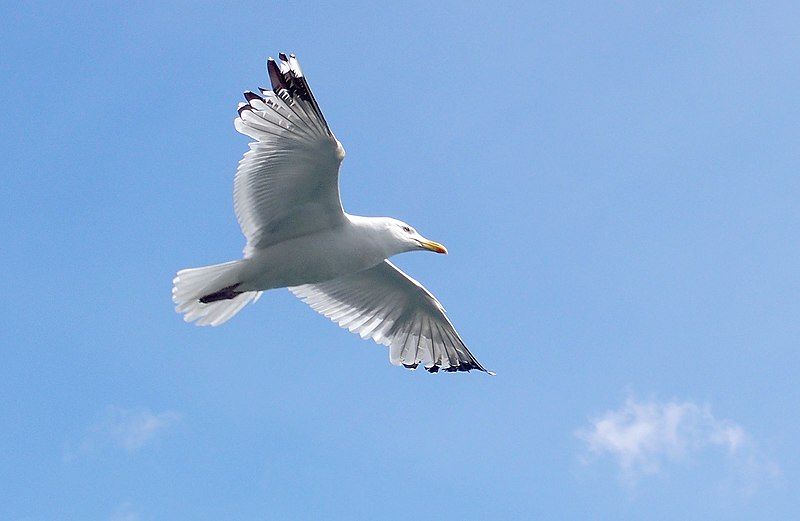
Gulls are a type of seabird belonging to the family Laridae and the suborder Lari. They are closely related to terns and skimmers, which are both types of seabirds. Furthermore, they are distantly related to auks and waders, both of which are also types of seabirds.
Gulls are often referred to as “seagulls”, and they can be found in many coastal regions across the world. Gulls are usually fairly large birds, with long wings and long forked tails.
They are highly social animals, often seen in large flocks, and they are also highly adaptable, able to feed on a variety of food sources. They are omnivores, meaning they eat a variety of things such as fish, insects, eggs, and even carrion.
Gulls are also known to scavenge for food, sometimes stealing from other birds or even humans. Gulls are important in their ecosystems, as they help recycle organic matter and keep other populations in check. They also provide food for other animals, such as whales and seals.
Gulls are also often seen as symbols of freedom and the open sea, and their calls are often associated with the sound of the ocean.
| Kingdom | Animalia |
| Phylum | Chordata |
| Class | Aves |
| Order | Charadriiformes |
| Family | Laridae |
2. Double-Crested Cormorant
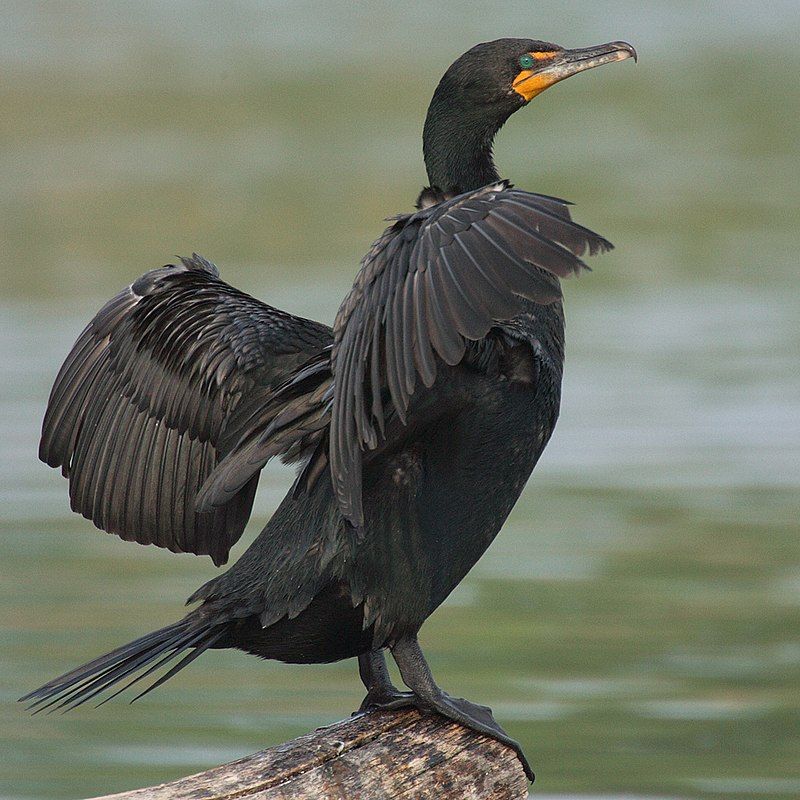
The double-crested cormorant is a widely distributed species of water bird belonging to the cormorant family. They are found in freshwater habitats, such as rivers and lakes, as well as coastal areas.
This species can be found in a large portion of North America, from the Aleutian Islands in Alaska all the way down to Florida and Mexico.
This range covers many different climates, from the cold weather of Alaska to the warm climate of Florida. The double-crested cormorant is an impressive bird that can be identified by its black feathers, yellow throat pouch, and two distinctive crests on the top of its head.
It has a wingspan of up to three feet and can be seen flying in flocks, often soaring in the sky in search of food.
This species feeds on fish, which it catches with its long, sharp beak. The double-crested cormorant is a social species that nest in colonies and breeds during the warmer months. In the winter, they migrate south, often flying in large flocks in search of warmer climates.
This species plays an important role in the local ecology, helping to keep fish populations in check. Overall, the double-crested cormorant is a unique species with a wide distribution range and an important ecological role.
It is an impressive bird to observe, with its distinctive crests and powerful flying ability. As such, it is an important species to protect and preserve.
| Kingdom | Animalia |
| Phylum | Chordata |
| Class | Aves |
| Order | Suliformes |
| Family | Phalacrocoracidae |
| Genus | Nannopterum |
| Species | N. auritum |
3. Common Murre
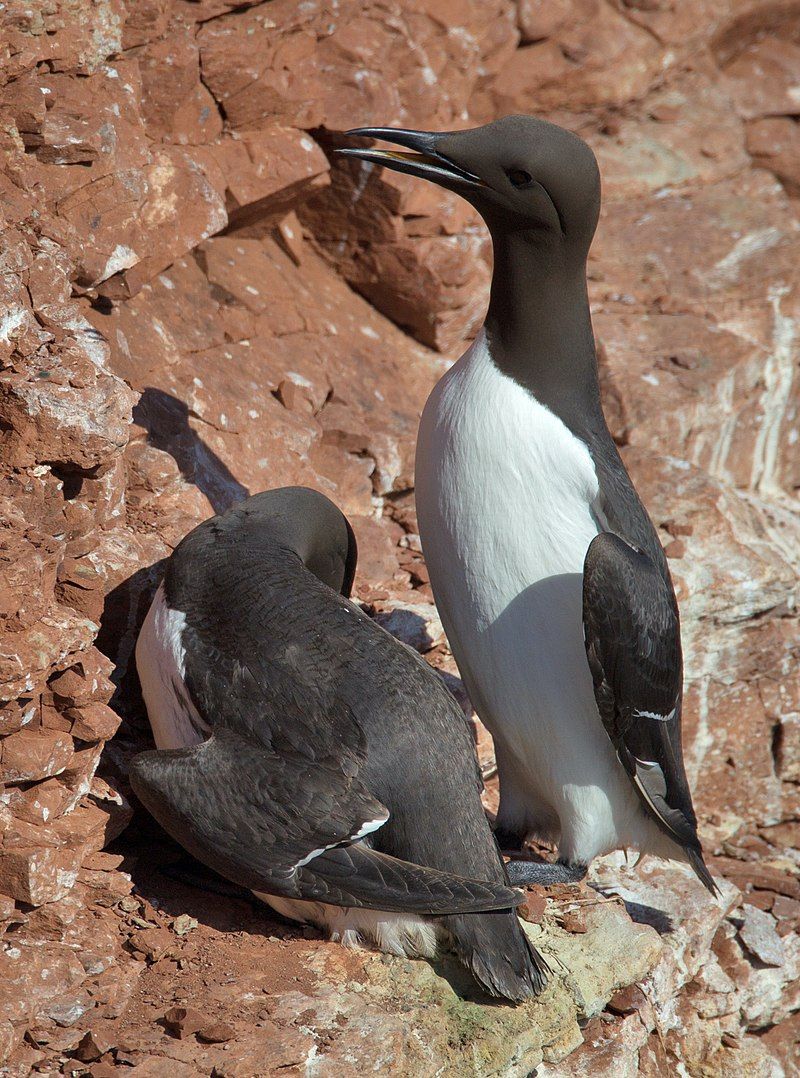
The common murre, also known as the common guillemot, is a species of large bird in the auk family. It is found in the North Atlantic and North Pacific regions, occurring in low-Arctic and boreal waters.
This species has a circumpolar distribution, which means that it can be found in many places around the Northern hemisphere. The common murre spends the majority of its time at sea, only coming to land to breed. Their breeding grounds are typically rocky cliff shores or islands.
During these breeding seasons, the birds form large colonies and lay eggs in shallow burrows or on ledges. The common murre is a hardy species, able to withstand both cold temperatures and harsh weather.
While it is an aquatic species, it is able to fly short distances and is an adept swimmer. It feeds primarily on small fish, molluscs, crustaceans, and plankton. The common murre is an important species to many different ecosystems.
Not only does it provide food for many species of fish, birds, and mammals, but it is also an important indicator species, helping scientists understand the health of the oceans.
| Kingdom | Animalia |
| Phylum | Chordata |
| Class | Aves |
| Order | Charadriiformes |
| Family | Alcidae |
| Genus | Uria |
| Species | U. aalge |
4. Magnificent Frigatebird
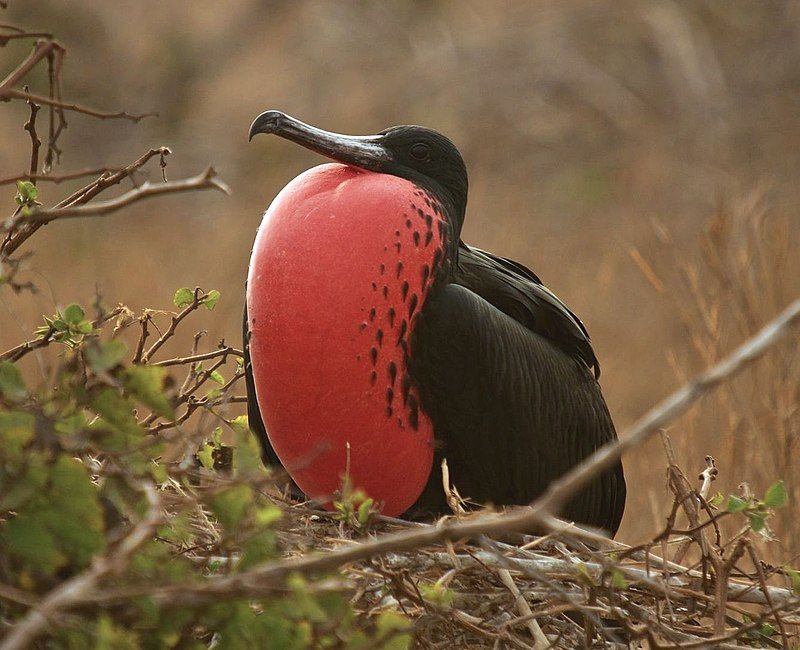
The magnificent frigatebird is an impressive seabird belonging to the family Fregatidae. It is a large bird, typically measuring 89-114 cm in length, with an impressive wingspan of 2.17-2.44 m. This makes it the largest species of frigatebird.
It is notable for its long, pointed wings and forked tail, as well as its impressive size. Its plumage is predominantly black, with white patches on its underwings and a white belly. The male also has a bright red throat pouch, which it inflates during courtship displays.
They have a long, hooked bill that is used to snatch food from the surface of the water. Frigatebirds are usually found in tropical and subtropical areas, particularly around oceanic islands. They feed primarily on fish, crustaceans, and squid.
They will also snatch food from other seabirds, which they can outmaneuver with their impressive flying ability. Frigatebirds are powerful and agile fliers, capable of soaring for hours at a time without flapping their wings.
This allows them to cover great distances quickly, and they have been known to travel up to 600 km in a single day.
| Kingdom | Animalia |
| Phylum | Chordata |
| Class | Aves |
| Order | Suliformes |
| Family | Fregatidae |
| Genus | Fregata |
| Species | F. magnificens |
5. Black-Footed Albatross
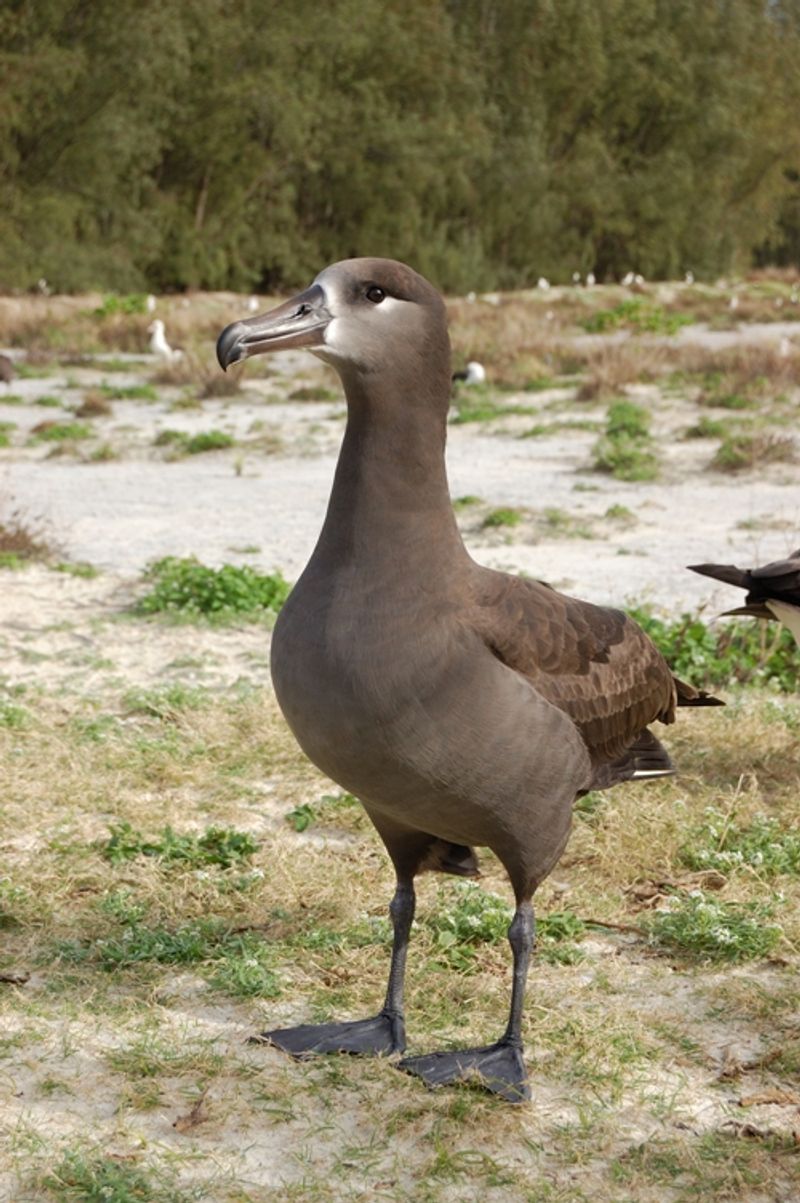
The black-footed albatross is a unique species of seabird that inhabits the North Pacific. It is one of the three species of albatross that range in the northern hemisphere, and is a part of the Diomedeidae family.
The majority of the species population, 97.5%, can be found among the Northwestern Hawaiian Islands. This is quite a remarkable feat, considering the fact that these islands are isolated tropical islands.
Inhabiting such islands, the black-footed albatross is able to thrive in its natural habitat, undisturbed by the increasing effects of human activity and environmental change.
This species of albatross is a vital part of the ocean ecosystem, and it is important that it is able to continue to live in its natural habitat.
| Kingdom | Animalia |
| Phylum | Chordata |
| Class | Aves |
| Order | Procellariiformes |
| Family | Diomedeidae |
| Genus | Phoebastria |
| Species | P. nigripes |
6. Blue-Footed Booby
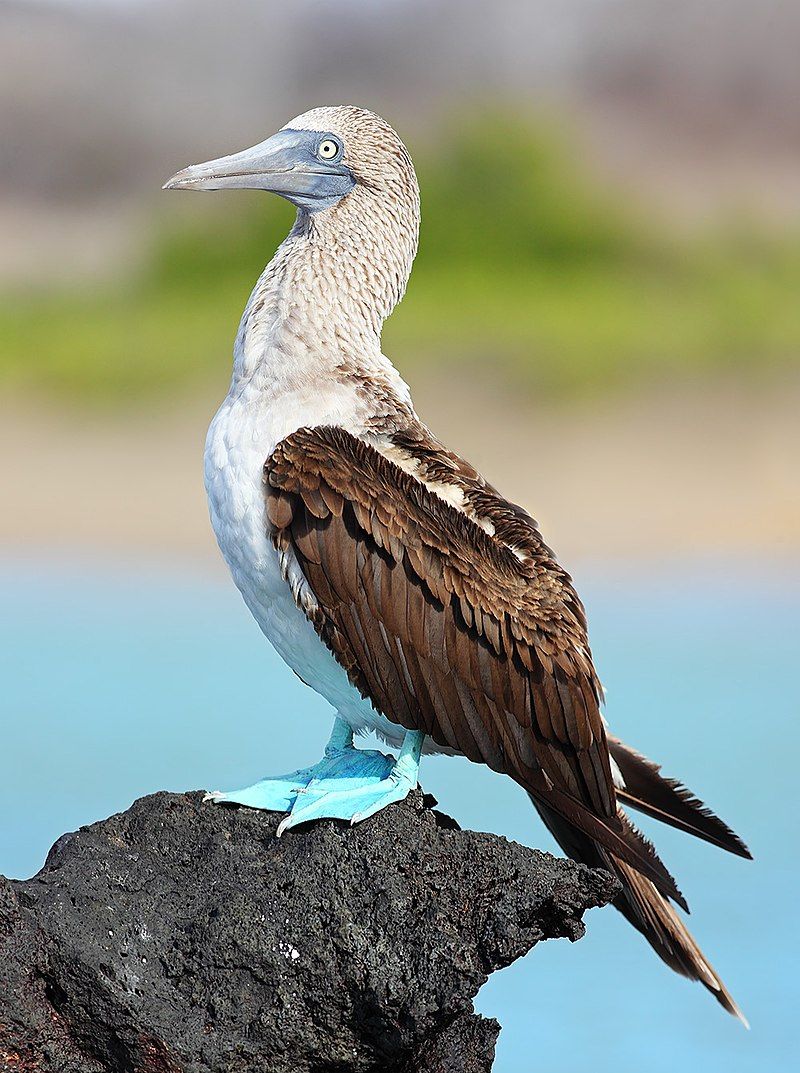
The blue-footed booby is a unique species of bird that is found in the eastern Pacific Ocean. It is part of the Sula genus, which is commonly known as boobies.
It is easy to recognize in its natural habitat due to its bright blue feet, which are a result of their diet and a sexually selected trait. Blue-footed boobies inhabit subtropical and tropical regions of the Pacific Ocean.
They are usually found in coastal areas such as coasts of South America, Mexico, and the islands of the Galapagos. The bright blue color of their feet is a result of their diet, which consists mainly of small fish and squid.
This diet gives them a unique color that helps them to stand out in their environment. The blue color of the booby’s feet is also a sexually selected trait.
This means that the male boobies with the brightest blue feet are more attractive to female boobies and therefore have a better chance of finding a mate. This trait helps to ensure the survival of the species by ensuring that the strongest individuals can reproduce.
The blue-footed booby is an impressive species of bird that is easily recognizable due to its distinctive bright blue feet. This is a result of their diet and a sexually selected trait which helps them to stand out in their environment and ensures the survival of the species.
| Kingdom | Animalia |
| Phylum | Chordata |
| Class | Aves |
| Order | Suliformes |
| Family | Sulidae |
| Genus | Sula |
| Species | S. nebouxii |
7. Oystercatchers
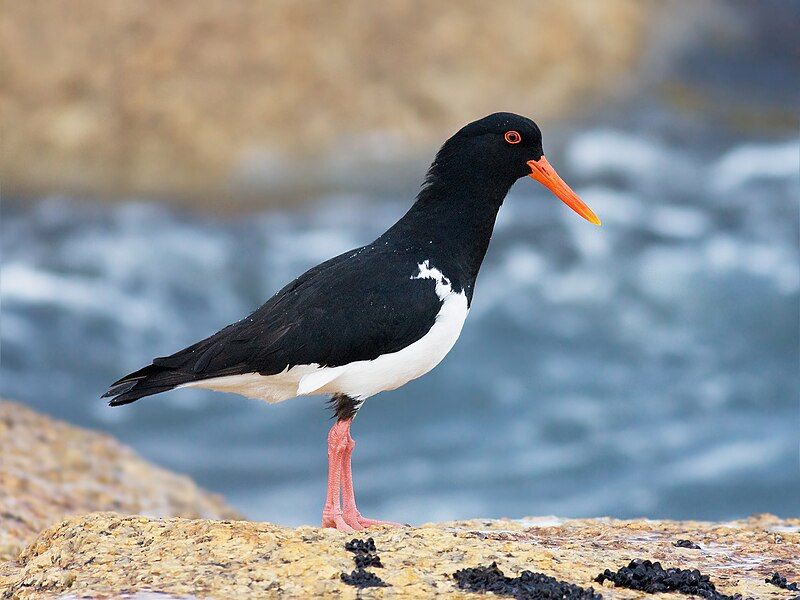
The oystercatchers are a distinct family of birds that belong to the Wader family. They are characterized by their single genus, Haematopus.
Oystercatchers inhabit most coastal regions of the world, with the exception of the polar regions and some parts of Africa and Southeast Asia. These birds are usually found near the coasts, where they feed on small crustaceans and mollusks.
They have long, bright orange-red beaks, which they use to catch prey. Oystercatchers are usually seen in small flocks, but they can also be seen alone or in pairs. They are easily identifiable by their distinctive black and white plumage.
They are highly sociable birds and have been known to form long-term bonds with one another. Oystercatchers are important to the coastal ecosystem, as they help to keep the water clean by consuming small invertebrates.
| Kingdom | Animalia |
| Phylum | Chordata |
| Class | Aves |
| Order | Charadriiformes |
| Family | Haematopodidae |
| Genus | Haematopus |
8. Brown Booby
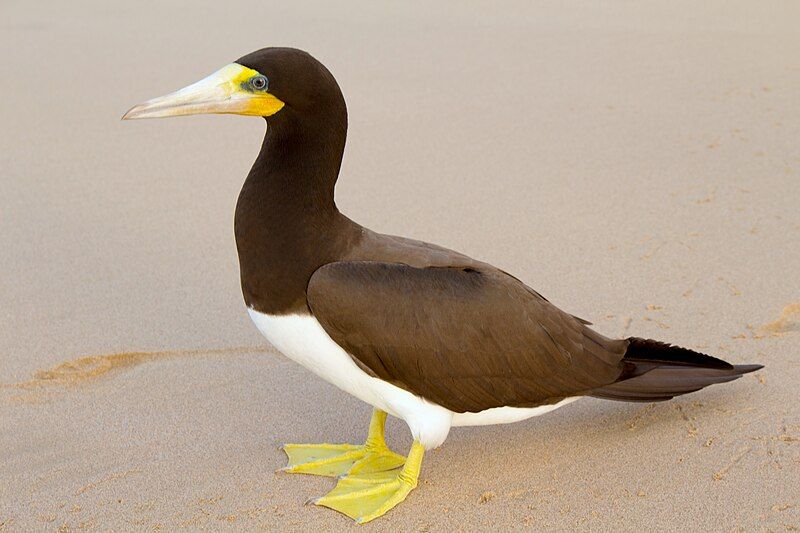
The brown booby is a large seabird belonging to the Sulidae family, also known as boobies. It is the most common and widespread species in the family, with a range spanning across the tropics. The brown booby is a gregarious bird, meaning it tends to gather in groups.
It is a strong flyer and commutes and forages over inshore waters at low altitudes. This range of the brown booby overlaps with that of other species of boobies, making it one of the most numerous seabird species in the world.
Its preferred diet consists of marine life such as fish, squid, and crustaceans, which it obtains by diving into the water from a low height.
In addition to its dietary habits, the brown booby is also known to nest in colonies that can range from small groups to large colonies of thousands of individuals.
| Kingdom | Animalia |
| Phylum | Chordata |
| Class | Aves |
| Order | Suliformes |
| Family | Sulidae |
| Genus | Sula |
| Species | S. leucogaster |
9. Marbled Murrelet
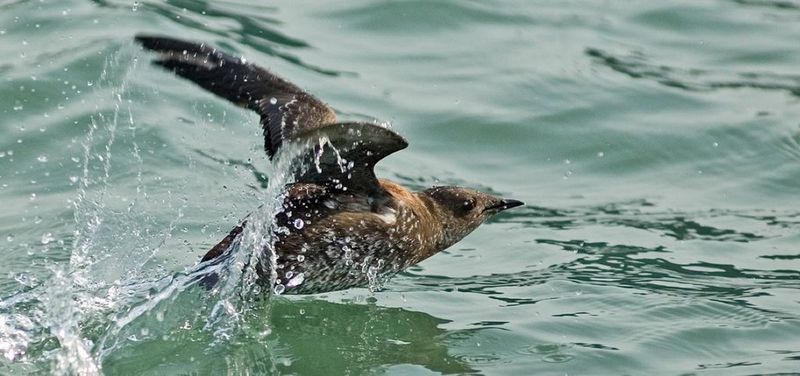
The marbled murrelet is a small seabird from the North Pacific region. It belongs to the family Alcidae, which is made up of a number of seabirds including auklets, guillemots, murres and puffins.
The marbled murrelet is unique among its relatives as it prefers to nest in old-growth forests or on the ground in higher latitudes where tree growth is not possible.
This is an adaptation that makes the marbled murrelet well-suited to its niche in the North Pacific region.The marbled murrelet is a highly specialized species, and its unique nesting habits are part of what makes it so successful.
The marbled murrelet relies on old-growth forests for shelter and safety, as these forests provide plenty of canopy and protection from predators.
Old-growth forests are also a great source of food for the marbled murrelet, as they often contain plenty of small fish and crustaceans, which the marbled murrelet eats. The marbled murrelet is an important part of the North Pacific ecosystem, as its nesting habits help to sustain old-growth forests.
These forests are vital for biodiversity, as they provide habitat for many other species, including other birds, mammals, and even plants.
The marbled murrelet’s presence in old-growth forests helps to maintain the health of these forests and the species that depend on them. The marbled murrelet’s unique adaptations have allowed it to thrive in the North Pacific region, and it is a vital part of the ecosystem.
Its presence helps to sustain old-growth forests, which are important for the health of the region and the species that inhabit it.
The marbled murrelet is a fascinating species, and its unique nesting habits are a testament to its adaptability and importance in the North Pacific.
| Kingdom | Animalia |
| Phylum | Chordata |
| Class | Aves |
| Order | Charadriiformes |
| Family | Alcidae |
| Genus | Brachyramphus |
| Species | B. marmoratus |
10. Northern Gannet
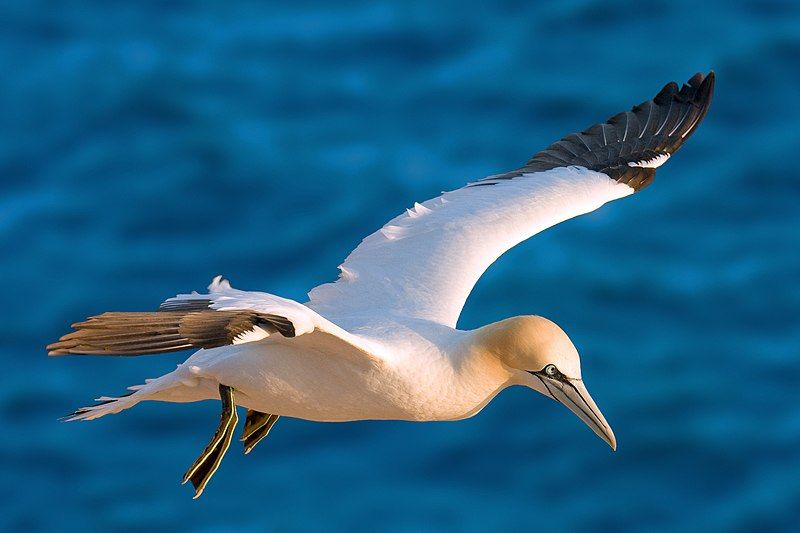
The northern gannet is one of the largest seabirds in the world, belonging to the Sulidae family, commonly known as gannets. It is native to the coasts of the Atlantic Ocean, breeding in both Western Europe and Northeastern North America.
The northern gannet is a beautiful bird, with a wingspan of up to 6 feet, and can be seen in its natural habitat soaring above the waves. Its body is predominantly white, with black tips at the wings and tail, while its head and neck are a bright yellow.
Both males and females look alike, making it difficult to distinguish between them. The northern gannet is a highly social bird, and can often be seen in large gatherings called a “gannetry”.
During the breeding season, they nest in large colonies, often built from seaweed and grasses. They feed mainly on fish, but will also eat crustaceans and squid.
Gannets have strong eyesight which helps them to spot prey from far away. The northern gannet is an important species in the Atlantic ecosystem, and is considered a symbol of strength and resilience.
It is a protected species in many countries, and its population has been increasing in recent years due to conservation efforts.
| Kingdom | Animalia |
| Phylum | Chordata |
| Class | Aves |
| Order | Suliformes |
| Family | Sulidae |
| Genus | Morus |
| Species | M. bassanus |
11. European Herring Gull
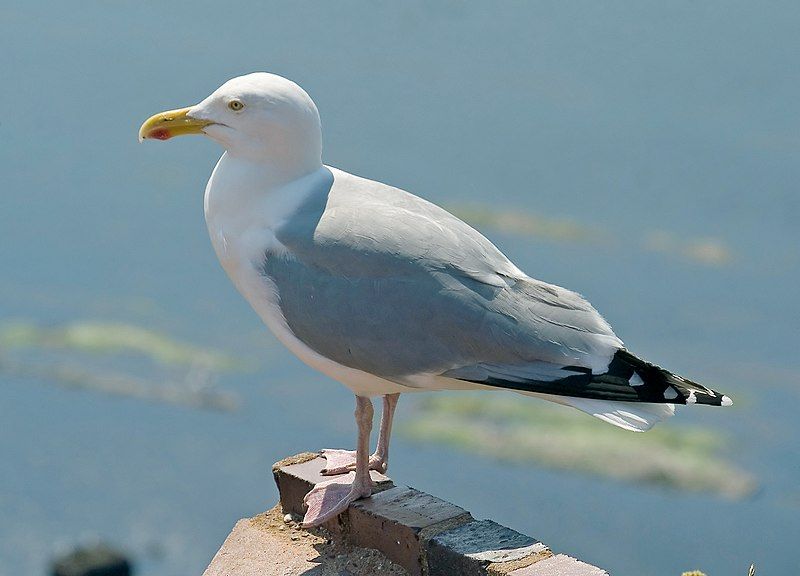
The European herring gull is a large bird species, measuring up to 66 cm in length. It is commonly found in coastal regions of Western Europe and was historically more abundant than it is now.
This species of gull breeds in a wide range of European regions, including Northern, Western, Central, Eastern Europe, Scandinavia, and the Baltic states.
They tend to breed in colonies, nesting on the ground, often near the edge of cliffs, in the arctic tundra, and in other areas that are close to water. These birds have a wide variety of food sources, including shellfish, insects, small fish, and carrion.
Due to its large range, the European herring gull is considered to be a species of least concern by the International Union for Conservation of Nature.
Although this species has shown a decline in population, there are ongoing conservation efforts to protect the species and its habitats.
| Kingdom | Animalia |
| Phylum | Chordata |
| Class | Aves |
| Order | Charadriiformes |
| Family | Laridae |
| Genus | Larus |
| Species | L. argentatus |
12. Laysan Albatross
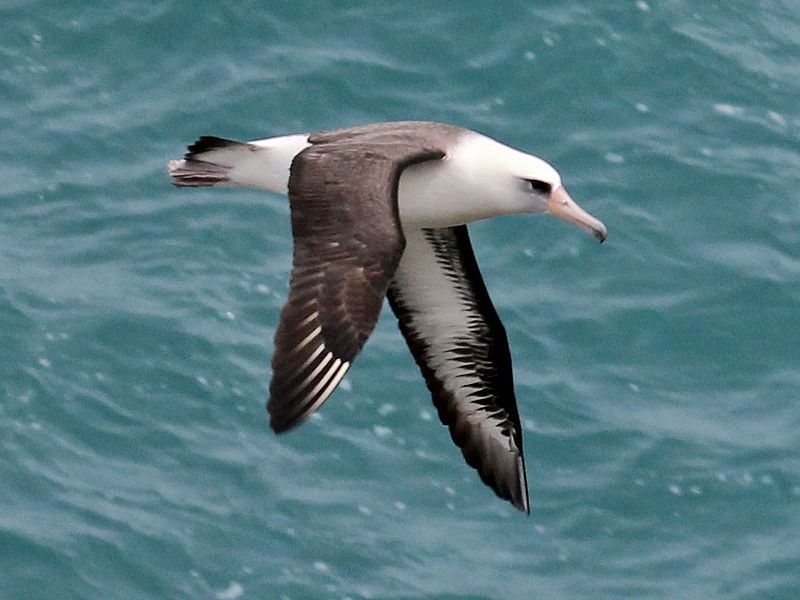
The Laysan albatross is a majestic creature, found across the North Pacific. It is a large seabird, with a wingspan of up to 8 feet and a body length of up to 39 inches. Its body is covered in white feathers, and its long wings are coloured white and black.
The Laysan albatross can be found on the coasts of North America, Japan, and the Hawaiian Islands. The Northwestern Hawaiian Islands are especially important for the Laysan albatross, as it is home to 99.7% of the species’ population.
This archipelago of small islands is the perfect habitat for the albatross, providing nesting sites and a place for them to forage for food.
The albatross can be found in large colonies on some of these islands, and they are known to go on long-distance flights in order to find food. The Laysan albatross is an iconic species, and it is vital that we protect their habitats and ensure their population remains healthy.
The Northwestern Hawaiian Islands are a key part of this and must be conserved in order to ensure the albatross can continue to thrive.
| Kingdom | Animalia |
| Phylum | Chordata |
| Class | Aves |
| Order | Procellariiformes |
| Family | Diomedeidae |
| Genus | Phoebastria |
| Species | P. immutabilis |
13. Razorbill
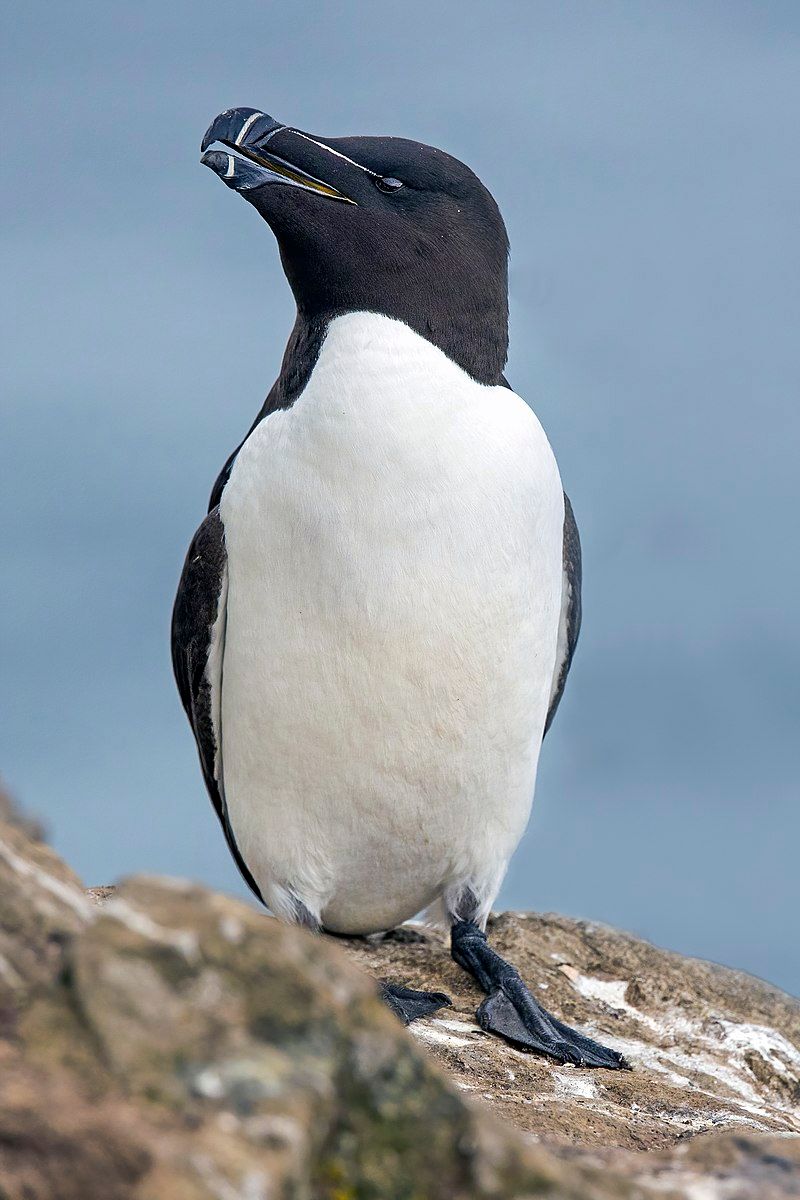
The Razorbill, or Razor-billed Auk, is a type of seabird that lives in the North Atlantic. It is a member of the Alcidae family, which is also known as the auk family.
It is the only living species in the Alca genus, making it the closest living relative of the Great Auk, which is now extinct. Razorbills have a distinct appearance, with a black upper body and a white underside.
They have a large, pointed bill, which is where they get their name from, and they can be up to 30 cm in length. They are strong swimmers and divers, and they can stay underwater for up to a minute at a time.
Razorbills prefer to nest in cliffs and rocky coasts, and they form large colonies when they breed. Razorbills have a variety of foraging techniques, including bottom-diving and surface-feeding.
They eat a range of small marine creatures, including crustaceans, molluscs, and fish. They also feed on seaweed, and they can sometimes be seen with other seabirds, such as puffins and murres.
Razorbills are considered to be a vulnerable species, due to issues such as pollution, overfishing, and habitat destruction. However, their population is currently stable, and conservation efforts have been successful in some areas.
| Kingdom | Animalia |
| Phylum | Chordata |
| Class | Aves |
| Order | Charadriiformes |
| Family | Alcidae |
| Genus | Alca |
| Species | A. torda |
14. Pigeon Guillemot
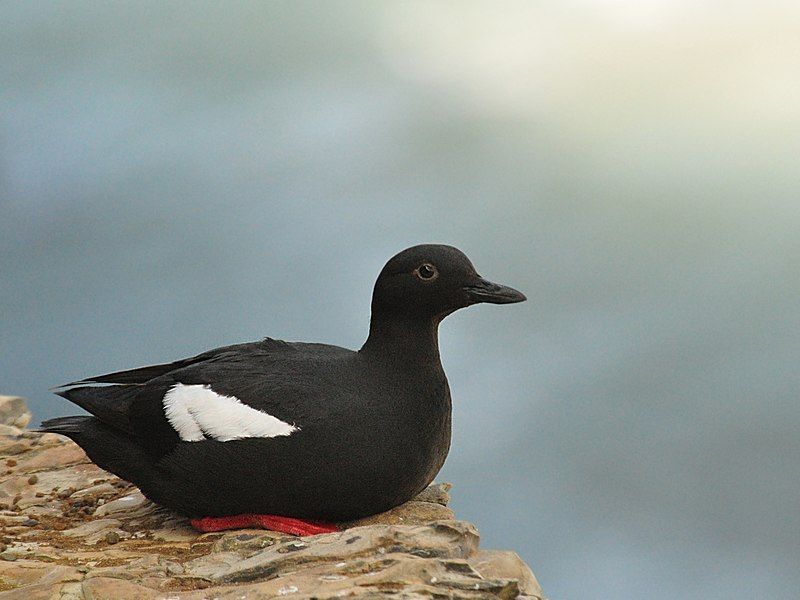
The pigeon guillemot is a species of bird belonging to the Alcidae family, which also includes puffins, murres, and auklets. It is one of three species in the Cepphus genus, the other two being the black guillemot and the spectacled guillemot.
The pigeon guillemot is the most closely related to the spectacled guillemot, with both species having similar physical characteristics, such as their sharp, pointed bills and their black and white markings.
They differ mainly in the shape of their bills, with the pigeon guillemot having a more curved bill than the spectacled guillemot.
The pigeon guillemot is found in coastal areas and islands in the Northern Pacific and Atlantic oceans, from Alaska and Canada down to California and Massachusetts. It is a medium-sized seabird, measuring between 30 and 40 cm in length, with a wingspan of up to 1 meter.
It has a black head and upperparts, and white underparts, with a thin white line along its wings. The pigeon guillemot is a monogamous species, with pairs forming for life.
It feeds mainly on small fish, crustaceans, and mollusks, which it captures by diving underwater from the surface of the sea. During the breeding season, the pair builds a nest in a rocky crevice or on the ground, and the female lays a single egg.
Both parents take turns incubating the egg, which hatches after around a month. The young are cared for by both parents until it can fly and is independent.
| Kingdom | Animalia |
| Phylum | Chordata |
| Class | Aves |
| Order | Charadriiformes |
| Family | Alcidae |
| Genus | Cepphus |
| Species | C. columba |
15. Western Gull
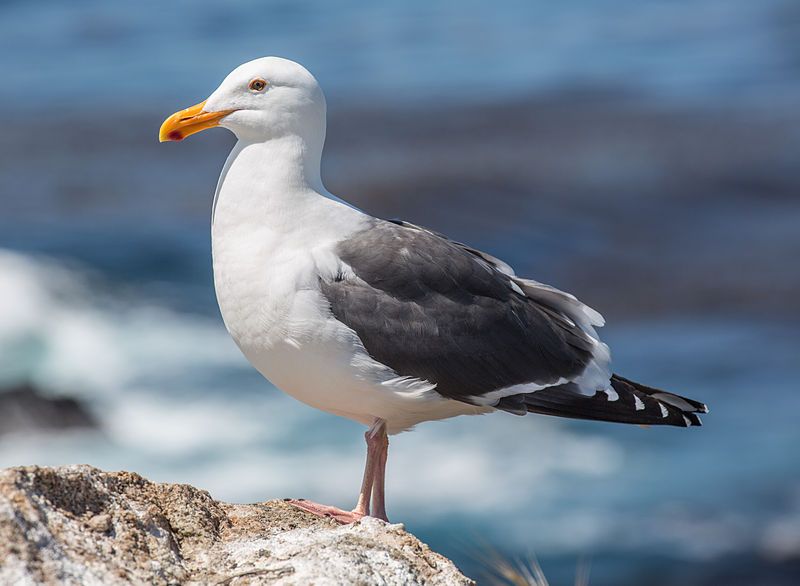
The western gull is a species of seabird native to the west coast of North America and the Pacific Ocean. It is a large white-headed gull, with a wingspan of up to 47 inches, and a body length of up to 24 inches.
The western gull ranges from British Columbia, Canada, to Baja California, Mexico, making it one of the most widely distributed gull species in North America. The western gull was previously considered the same species as the yellow-footed gull of the Gulf of California.
The yellow-footed gull is slightly smaller than the western gull, and its range is more limited, as it is only found in the Gulf of California and a few adjacent areas.
However, recent taxonomic studies have determined that the two species are distinct, and the western gull is now classified as a distinct species.
| Kingdom | Animalia |
| Phylum | Chordata |
| Class | Aves |
| Order | Charadriiformes |
| Family | Laridae |
| Genus | Larus |
| Species | L. occidentalis |
16. Pelagic Cormorant
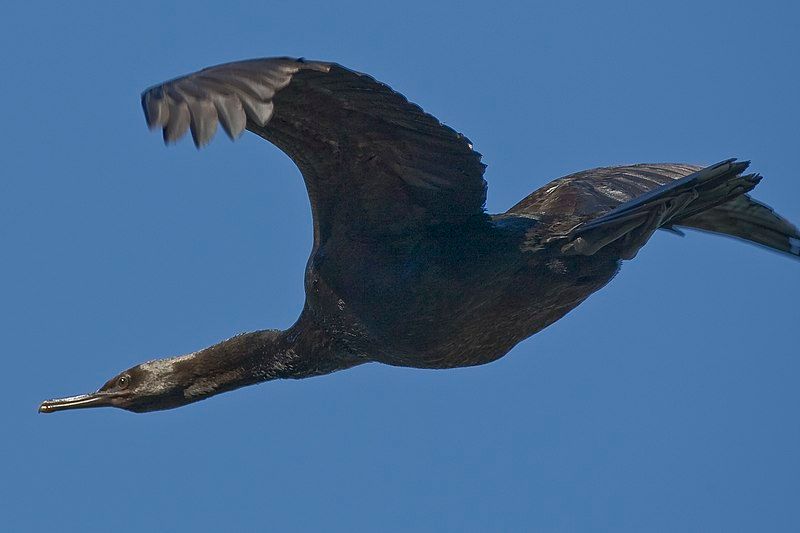
The Pelagic Cormorant is a species of cormorant belonging to the family Phalacrocoracidae. It is also known as Baird’s Cormorant or Violet-Green Cormorant, due to its distinctive colour.
It is one of the smallest species of cormorant, and is sometimes referred to as the Pelagic Shag. This bird typically has a black head and neck, with a white spot on the throat, a pale grey body, and a greenish-violet sheen on the wings and tail.
Its legs and feet are black, and it has a yellowish bill with a black tip. The Pelagic Cormorant is a highly aquatic bird, with a diet comprised mainly of fish. It prefers to hunt in deep, open water and is often seen diving into the sea to feed.
It is also highly migratory, with large numbers of birds travelling to coastal areas during the winter months. Its habitat is mainly along the Pacific Coast of North America, from Alaska to Mexico, and it is also found in parts of Europe, Asia and Africa.
The Pelagic Cormorant is an important species to the region’s marine ecosystem, as it helps to keep the populations of other fish species in check. Unfortunately, its numbers have been declining in recent years due to habitat destruction and overfishing.
As a result, it is now listed as Near Threatened by the IUCN Red List of Threatened Species.
| Kingdom | Animalia |
| Phylum | Chordata |
| Class | Aves |
| Order | Suliformes |
| Family | Phalacrocoracidae |
| Genus | Urile |
| Species | U. pelagicus |
17. White-Tailed Tropicbird
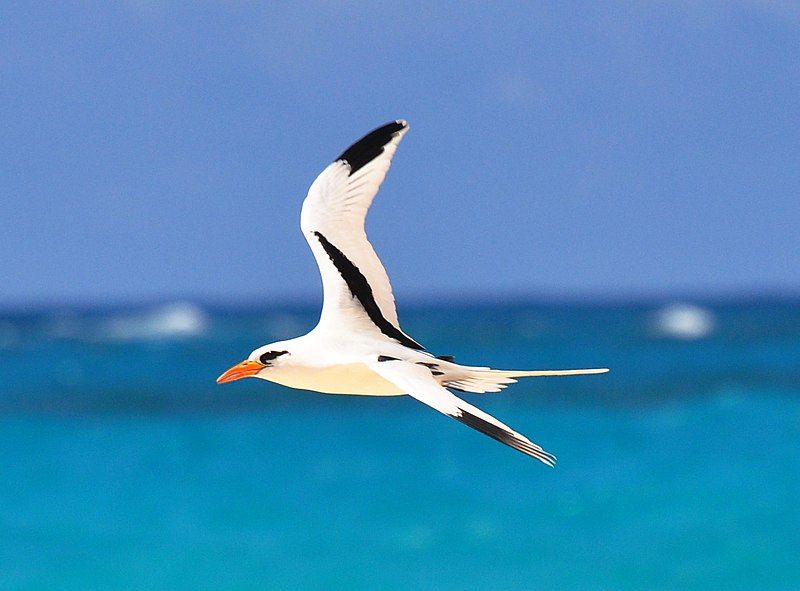
The white-tailed tropicbird is a unique bird belonging to the order Phaethontiformes. This order consists of three closely related species of seabirds that live in tropical oceans.
The white-tailed tropicbird is the smallest of these three species and is found in the tropical Atlantic, western Pacific and Indian Oceans. This bird has a distinct white-tailed plumage, with a long tail streamer that can be up to twice as long as its body.
Its head is white and its wings are blackish-brown, with the exception of a white patch near the tips of the wings. The underside of the bird is mostly white, with a few black streaks along the tail.
The bill is yellow-orange and the eyes are dark. The white-tailed tropicbird typically breeds on islands, nesting in burrows or on ledges. This bird is a strong flier and is known to travel long distances in search of food.
Its diet mainly consists of fish, squid and crustaceans. The white-tailed tropicbird is considered a species of least concern by the International Union for Conservation of Nature (IUCN).
However, its population is declining due to habitat destruction, pollution, overfishing and other human-related activities. Conservation efforts are needed to ensure the survival of this species.
| Kingdom | Animalia |
| Phylum | Chordata |
| Class | Aves |
| Order | Phaethontiformes |
| Family | Phaethontidae |
| Genus | Phaethon |
| Species | P. lepturus |
18. Northern Fulmar
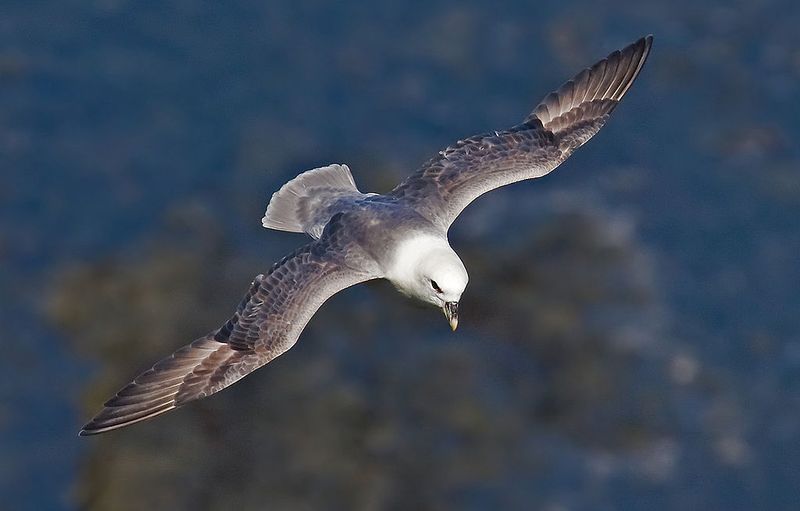
The northern fulmar is a highly abundant seabird found primarily in the subarctic regions of the North Atlantic and North Pacific oceans.
This species of seabird is mainly found in the Northern Hemisphere, yet there has been one confirmed sighting of a single bird in the Southern Hemisphere.
This bird was observed south of New Zealand, making it the only known sighting of a northern fulmar in the Southern Hemisphere. The northern fulmar is a medium-sized seabird with a long wingspan and a slender body.
It mainly feeds on small fish, plankton, and other marine creatures. This species of seabird is also known for its long-distance migration patterns, with some flying up to 8,000 miles to reach their wintering grounds.
Interestingly, the northern fulmar is a particularly resilient species, which is able to survive and thrive in harsh conditions, such as icy waters and strong winds. The northern fulmar is an important species for the marine ecosystem, as it helps to maintain the balance in the food chain.
It is also an important source of food for other species, such as whales, dolphins, and seabirds.
The northern fulmar is a species of seabird that is still relatively common, but the sighting in the Southern Hemisphere is a reminder that we should be mindful of the conservation of this species and its habitats.
| Kingdom | Animalia |
| Phylum | Chordata |
| Class | Aves |
| Order | Procellariiformes |
| Family | Procellariidae |
| Genus | Fulmarus |
| Species | F. glacialis |
19. Roseate Tern
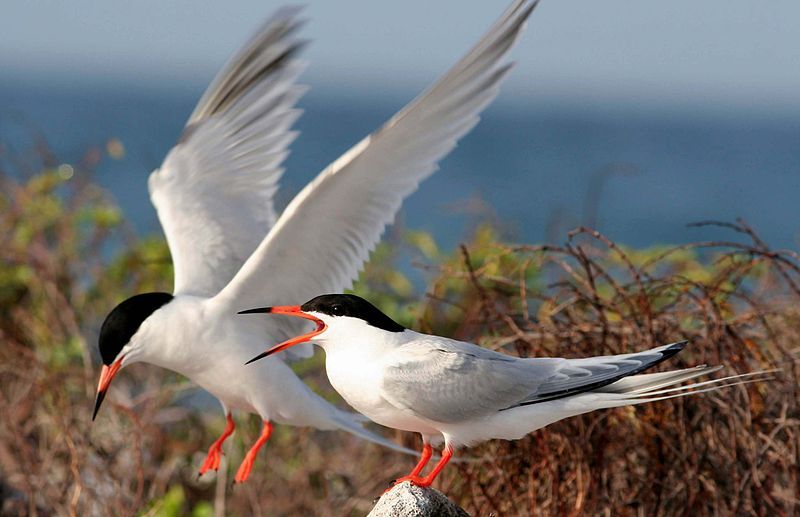
The roseate tern is a species of tern belonging to the family Laridae. It is scientifically classified as Sterna dougallii, which is derived from Old English “stearn”, meaning “tern”. The specific dougallii refers to the Scottish physician and collector Dr.
Peter McDougall, who first discovered and studied the species. The term “roseate” is used to describe the bird’s unique pink breast that it gets when it is in breeding plumage.
This coloration is one of the most distinguishing features of the species, and is why it has been given the name “roseate tern”.
| Kingdom | Animalia |
| Phylum | Chordata |
| Class | Aves |
| Order | Charadriiformes |
| Family | Laridae |
| Genus | Sterna |
| Species | S. dougallii |
20. Wandering Albatross

The wandering albatross is a large seabird, belonging to the family Diomedeidae. It has a circumpolar range, meaning that it can be found in the Southern Ocean all year round.
It is also known as the snowy albatross, white-winged albatross, or goonie. The wandering albatross has a wingspan of up to three and a half meters, making it one of the largest flying birds.
Its wings are white with a black leading edge and have a distinctive shape, which makes them well-suited for efficient gliding.
It spends much of its time in the air, soaring on the updrafts of air created by the ocean. The wandering albatross mainly feeds on squid and fish, but it also takes carrion and occasionally seabird chicks.
It hunts by either dipping down and snatching prey from the surface of the water or by skimming the water with its bill. The wandering albatross is a highly social bird, often seen in flocks of several hundred individuals.
It spends the majority of its life at sea, only coming ashore to breed. The wandering albatross is a long-lived species, with some individuals reaching up to 40 years of age. Overall, the wandering albatross is a unique and fascinating bird that is a joy to watch.
It is a species of conservation concern, listed as Vulnerable on the IUCN Red List of Threatened Species. Conservation efforts are needed to ensure the continued survival of this majestic species.
| Kingdom | Animalia |
| Phylum | Chordata |
| Class | Aves |
| Order | Procellariiformes |
| Family | Diomedeidae |
| Genus | Diomedea |
| Species | D. exulans |
21. Red-Tailed Tropicbird
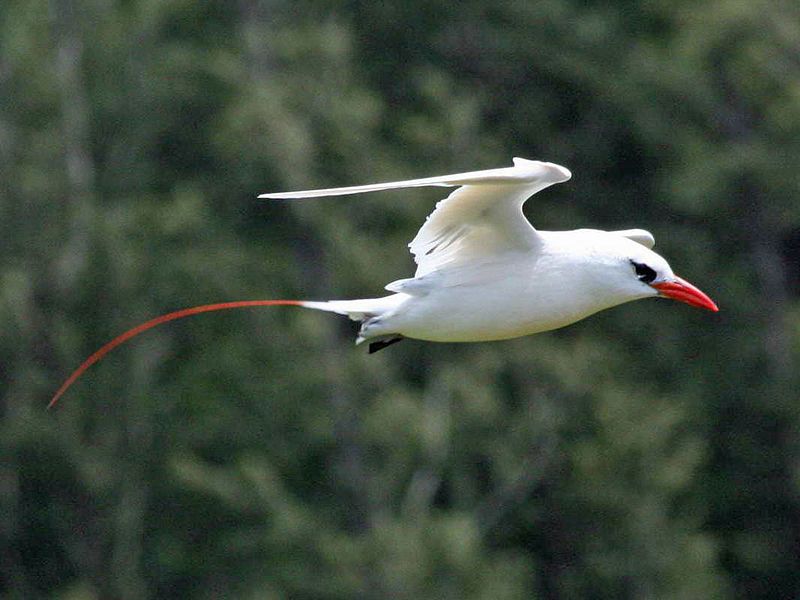
The red-tailed tropicbird is a beautiful seabird found in tropical parts of the Indian and Pacific Oceans. It was first described by Pieter Boddaert in 1783. From a distance, this bird has a similar appearance to a tern, with its white plumage, black mask, and red bill.
However, upon closer inspection, the bright red tail of the red-tailed tropicbird easily sets it apart from other seabirds. The red-tailed tropicbird is one of three closely related species of tropicbird.
These species have adapted to living in tropical climates, where they feed on fish, squid, and crustaceans. These seabirds are often seen soaring over the ocean’s surface, gliding on the wind currents with their long wings.
They nest in sheltered cliffs and rocky areas near the ocean, usually in colonies with other tropicbirds. The red-tailed tropicbird is an incredible bird, with its striking white plumage, black mask, and distinctive red bill and tail.
It is a beautiful sight to see these birds gracefully gliding above the ocean’s surface, and their presence serves as a reminder of the beauty of our planet’s natural environment.
| Kingdom | Animalia |
| Phylum | Chordata |
| Class | Aves |
| Order | Phaethontiformes |
| Family | Phaethontidae |
| Genus | Phaethon |
| Species | P. rubricauda |
22. Brandt’s Cormorant
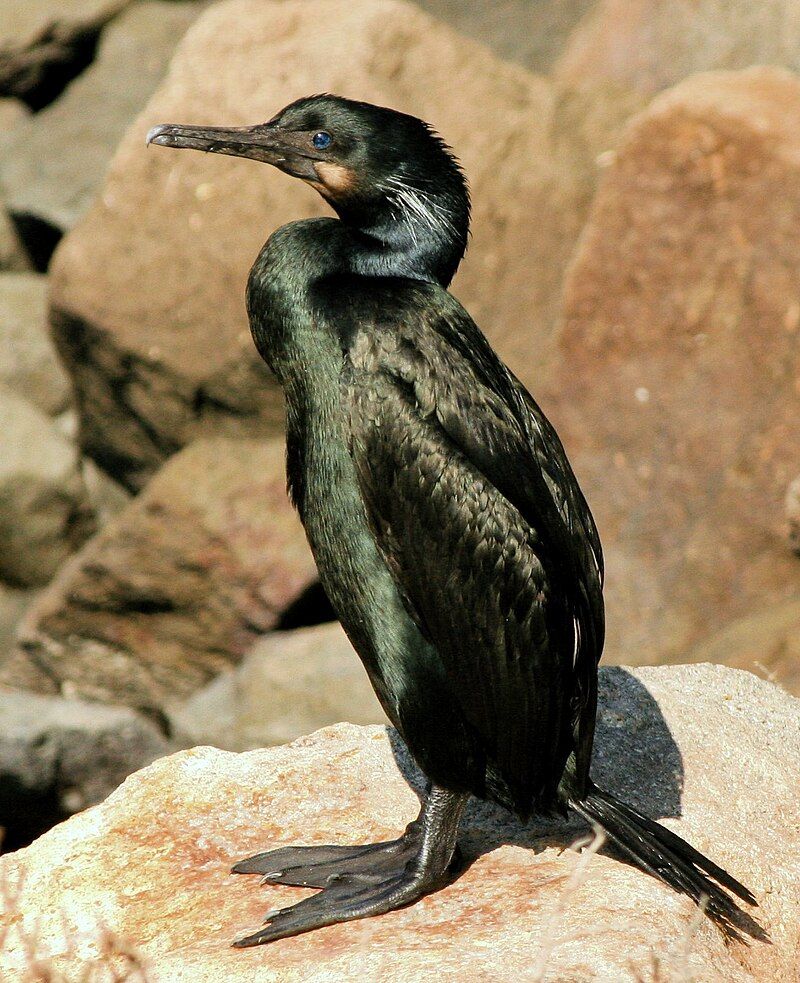
Brandt’s cormorant is a species of seabird that is found along the Pacific coast of North America. This species is unique because it is strictly marine, meaning that it spends most of its time away from land and prefers to stay close to the ocean’s surface.
During summers, Brandt’s cormorant can be found as far north as Alaska, and as far south as the Gulf of California. However, the population of this species that resides north of Vancouver Island migrates south during the winter months.
This behavior is thought to be the bird’s way of finding more favorable feeding grounds during the colder weather.
The winter migration of Brandt’s cormorant is also believed to be a way for these birds to avoid the harsher weather conditions that are found in the northern parts of their range.
| Kingdom | Animalia |
| Phylum | Chordata |
| Class | Aves |
| Order | Suliformes |
| Family | Phalacrocoracidae |
| Genus | Urile |
| Species | U. penicillatus |
23. Snowy Plover
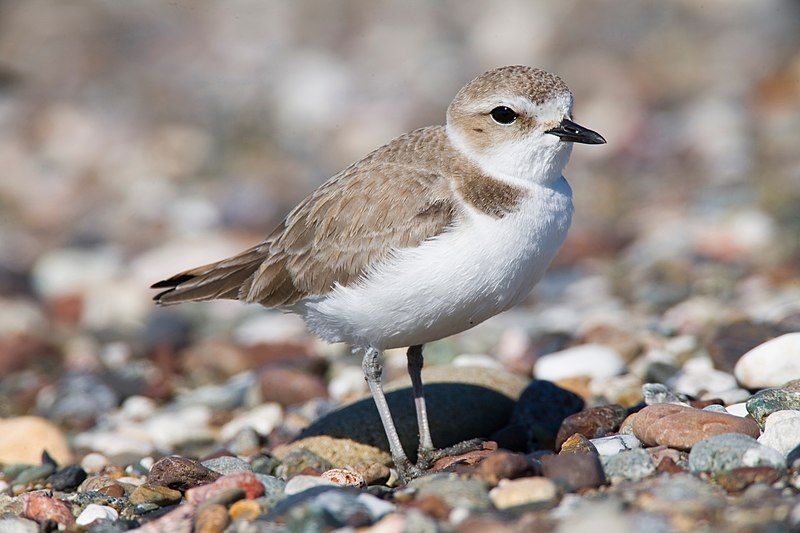
The snowy plover is a species of bird belonging to the plover family, which is characterized by its small size of 5-7 inches in length. It is native to regions in the United States, the Caribbean, Ecuador, Peru, and Chile.
It was previously classified as a subspecies of the Kentish plover, but recent research has confirmed it as a distinct species. The snowy plover is a shorebird and is known for its white plumage and dark spots.
Its preferred habitat is in coastal regions with sandy beaches and mudflats, where it feeds on a variety of invertebrates. During the breeding season, the snowy plover will typically lay four eggs in a shallow nest on the ground.
The female will incubate the eggs for around 24 days, and the chicks will fledge after approximately 20 days. The snowy plover is listed as endangered in some parts of its range and is threatened by habitat destruction and human disturbance.
As such, conservation efforts are being undertaken to ensure the species’ survival. This includes habitat protection and the adoption of practices to reduce human disturbance on beaches and mudflats.
| Kingdom | Animalia |
| Phylum | Chordata |
| Class | Aves |
| Order | Charadriiformes |
| Family | Charadriidae |
| Genus | Charadrius |
| Species | C. nivosus |
24. Black Noddy
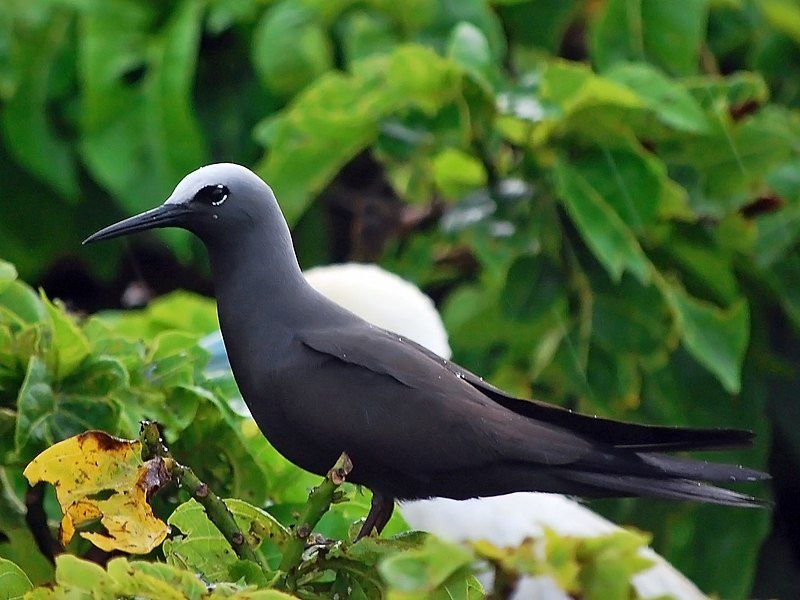
The black noddy, also known as the white-capped noddy, is a species of seabird in the family Laridae. It is a medium-sized tern, with predominantly black plumage and a distinctive white cap.
This white cap is what gives the black noddy its other name, and is what distinguishes it from the lesser noddy with which it was formerly considered to be the same species. The black noddy has a wingspan of up to 45 centimeters and a body length of around 28 centimeters.
It has a short, thin black beak, which it uses for catching fish and other small aquatic prey. Its wings are black on top, with a white underside, and its tail is forked. Its legs and feet are black.
The black noddy typically breeds in large colonies, gathering on islands and coastal areas near the ocean. It nests on the ground, typically in a shallow scrape and lays two or three eggs in a clutch. The chicks are covered in soft down and are cared for by both parents.
The black noddy is a migratory species which can be found in tropical and subtropical regions around the world. Its diet consists mostly of small fish, crustaceans and other invertebrates.
It is not considered to be threatened, although its population may be in decline due to habitat destruction and other human activities.
| Kingdom | Animalia |
| Phylum | Chordata |
| Class | Aves |
| Order | Charadriiformes |
| Family | Laridae |
| Genus | Anous |
| Species | A. minutus |
Conclusion
Birds play an important role in the Oceano ecosystem. They provide food for other animals, help to pollinate plants, and help to keep the environment healthy. They also provide a source of enjoyment and recreation for people.
Birds are a vital part of the Oceano environment, and we should strive to protect them and their habitats.